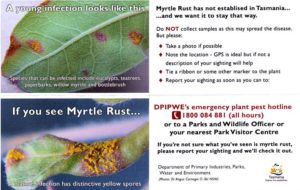Myrtle Rust is a member of the guava rust complex caused by Puccinia psidii, a known significant pathogen of Myrtaceae plants outside Australia, and was first detected on the Central Coast of NSW in 2010.
It has now firmly established itself along the east coast of Australia from southern New South Wales to far north Queensland, and in some parts of Victoria. Its spores spread rapidly and by air, making whole eradication unfeasible. However, areas such as Wambina Nature Reserve have eradication plans and are quarantined.

Tasmania’s efforts to educate bushwalkers included a Myrtle Rust ID card.
Studies have found that at least 347 Australian Myrtaceae species are susceptible.
The most notably affected are eucalypts (Eucalyptus, Angophora and Corymbia), paperbarks and bottlebrushes (Melaleuca and, formerly, Callistemon), and tea-trees (Leptospermum).
Myrtle Rust attacks young, soft, actively growing leaves, shoot tips and young stems, as well as fruits and flower parts of susceptible plants.
The first signs of myrtle rust infection are tiny raised spots that are brown to grey, often with red-purple haloes.
After infection, the spots produce masses of distinctive yellow spores.
The fungus is spread very easily by these spores through the air and water, and can also accumulate on clothing, gloves, hats, tents, watches, wristbands and other gear.
Bushland that we visit could be infected with Myrtle Rust. Remember to arrive clean and leave clean, pack light, carpool when possible and leave cars in carpark areas or away from bush.
If there is any chance that you have encountered the fungus, change into fresh clothes and wash your hands, face and footwear to prevent it spreading. Clean your shoes with a 70% methylated spirits or benzyl alkonium chloride disinfectant.
Standard washing-machine use with detergent will kill Myrtle Rust spores on clothing, gloves, hats and other items suitable for the washing machine. Brush up on how to Clean Your Gear and see our Solutions page for information.
Notes:
https://www.invasives.org.au/project/myrtle-rust
https://www.dpi.nsw.gov.au/biosecurity/plant/established-plant-pests-and-diseases/myrtle-rust
http://www.environment.nsw.gov.au/resources/pestsweeds/110683myrtlerustmp.pdf
http://dpipwe.tas.gov.au/Documents/myrtle.pdf
https://invasives.org.au/wp-content/uploads/2017/11/Case-Study-Myrtle-rust.pdf
https://invasives.org.au/wp-content/uploads/2014/02/fs_myrtle_rust.pdf
Update:

Comments are closed.